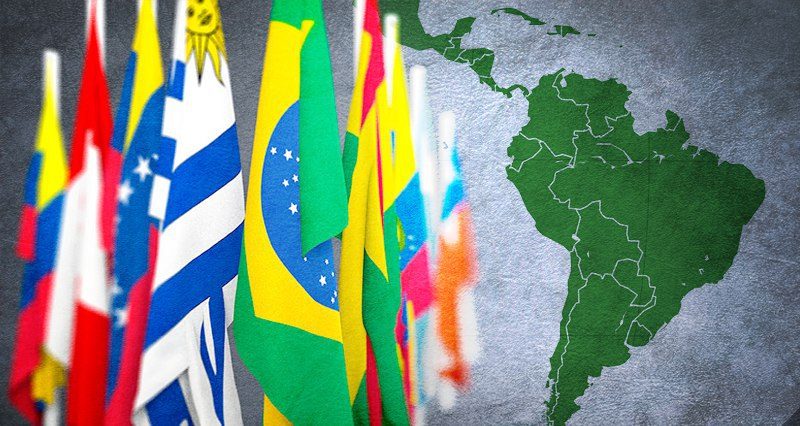RIO DE JANEIRO, BRAZIL – (REUTERS) Peru’s closely watched presidential election race between two polarized candidates is the latest in a string of political risk events haunting investors in Latin America, a region struggling to keep up with its global peers despite a commodities boom.
Latin America was engulfed in social unrest before the Covid-19 pandemic hit. Now a string of elections that continues into 2022, protests in Colombia, and upheaval over Chile’s constitution, all have investors bracing for a new wave of uncertainty over policy making.
On top of that, the coronavirus is still ravaging the region, with Argentina, Colombia, Brazil and Chile recording far more confirmed cases per million people than India.
“The market, and investors in general, are very nervous about Latin America,” said Ricardo Adrogue, head of the global sovereign debt and currencies group at Barings investment bank.
“Latin America is at a very difficult juncture. It is having elections at a time when (Covid-19) has been so painful, so deadly and so widespread in so many countries in the region, which makes for a potential change in economic and policy direction.”
Latin America’s economy shrank 7% last year, the sharpest contraction of all emerging regions, according to the International Monetary Fund. Rising global inflation pressures and yields hit the region disproportionately with hard-currency and local bonds lagging in 2021 and many of its currencies underperforming.
Booming commodity prices failed to provide much relief in a region dominated by basic resource exporters. This year’s 4.7% growth forecast hinges on the recovery staying on track despite sluggish vaccination progress.
“Heightened political volatility has taken the shine off a lot of the positive things with respect to the commodity price impact on the region,” said Angus Bell at Goldman Sachs Asset Management.
“There’s obviously been news flow in Peru, there’s things going on in Chile, we’re also coming into an election cycle in Brazil where the former president is back in the picture.”
Peru’s sol has been on a rollercoaster as polls show socialist Pedro Castillo – pushing for more taxes and royalties on the mining sector – leading right-wing Keiko Fujimori ahead of the June 6 presidential vote.
The sol has fallen 5% over the last nine sessions to touch a historic low Wednesday of 3.8538 to the dollar.
Gustavo Petro, a former insurgent whose former closeness with late Venezuelan President Hugo Chavez and social spending proposals raise fiscal discipline eyebrows, leads early polling in Colombia’s presidential 2022 election.
Former leftist President Luis Inacio Lula da Silva seems to have a shot at unseating far-right President Jair Bolsonaro next year in Brazil, while Chile’s vote this month for a constitutional assembly dealt a blow to the governing center-right coalition ahead of November presidential elections.
In Ecuador, Guillermo Lasso’s surprise victory in April’s presidential election marked a rare win for the right in the current election cycle.
Despite a perceived default rejection to leftist politics among market participants, the rise of left wing politics far from equates to a negative fallout for markets, as Ecuador’s President Lenin Moreno or Mexico’s Andrés Manuel López Obrador show.
But some investors are wary of sharp policy shifts putting the key mining sector into the crosshairs, or economies going the way of Venezuela where a long economic downturn developed into a humanitarian crisis, or even just Argentina, severely hobbled by a combined inflation and debt chokehold.
“Political cycles tend to go in waves and I think we are in the earlier stages of a left-leaning political wave in Latin America,” said Peter Gillespie, equities portfolio manager at Lazard Asset Management, which invest mainly in Mexico, Brazil, Peru and Colombia.
Mexico holds mid-term elections on June 6. At stake is control of the budget for the rest of López Obrador’s term, and possible changes to the constitution if he follows through on threats to defy courts that have hampered his objective to broaden the state’s role in the economy.
Latin American stocks lag other regions by at least 18 percentage points since the start of 2020 as the region struggles to recover from the crisis.
Rising unemployment and inequality have sparked fresh unrest. In Colombia deadly protests are in their fourth week following a push on tax and health reforms.
“We remember the social movements of 2019 — some countries are seeing resurgences in 2021, reflecting circumstances that need to be corrected in many Latin American countries,” said Alejandro Werner, IMF director for the Western Hemisphere.
Colombia’s peso, down over 8% this year versus the dollar, is among the worst-performing currencies globally in 2021. The fallout has been swift, with no let-up in sight. S&P Global cut Colombia’s credit rating to junk, with more downgrades expected.
An S&P analysis of credit default swaps implies a two-notch downgrade in the credit rating of Peru and Chile and a one-notch cut in Mexico, barely keeping it in investment grade.
“COVID, just as it does in the human body, exposes pre existing conditions. And there was a kind of erosion in the faith of the ability of democracy to deliver in an increasing number of countries across the region,” said Dan Restrepo, senior fellow at the Center for American Progress.
“We’re in for some rocky times politically, and as a result economically, in a number of the countries in the region.”


